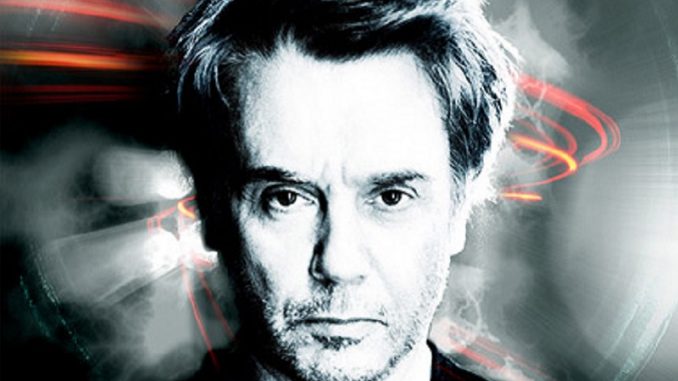
AUK continues its series looking at the musical tastes of AUK writers beyond the Americana genre.
It all started with a double-album on a single cassette release of ‘Oxygene‘ and ‘Equinox‘. Here was the sound of the future, the soundtrack to a thousand science fiction short stories read and unmade films imagined. Jean-Michel Jarre was the sound of Harlan Ellison, the sound of Asimov – I was deeply obsessed by the BBC’s radio adaptation of ‘The Foundation Trilogy‘ which was peppered with the sounds of the Radiophonic Workshop. It was the art of Chris Foss turned into sound. And it’s Jean-Michel Jarre’s music that I fervently believe forced me to listen to a wider range of long form instrumental music, ‘Oxygene‘ and ‘Equinox‘ are both symphonic works with repeated motifs and an intelligence which runs throughout the album. And that was something quite different from a lot of the other electronic music emerging at the time. Unfathomly never as cool as Kraftwerk, and often bizarrely regarded at the time as secondary to say Isao Tomita – bizarre because Jarre created new music, whilst Tomita reworked the classics which arguably were doing ok on their own thanks very much. Jarre though was painting big with his sounds, the huge canvas concept being something which he would carry through to his “cities in concert” playing to audiences numbering in millions and for the Houston concert aiming to include a live contribution from the NASA Spacelab which only the destruction of the Spaceshuttle Challenger prevented. Thinking big.
There are, essentially, two kinds of Jarre albums. There are the symphonic works – ‘Oxygene‘, ‘Oxygene 7-13‘, ‘Oxygene 3’, ‘Equinox‘, ‘Equinox Infinity‘, ‘Les Chants Magnétiques‘, for example. And there are the travelogues – ‘En attendant Cousteau‘, ‘Zoolook‘, ‘Revolutions‘ where Jarre crosses over to a new hybrid of electronica and non-European traditional music (“world music” if you really must). These also tend to be where Jarre flexes his political muscle – ‘En attendant Costeau‘ of course has environmental concerns, ‘Revolutions‘ discourses bluntly on inequality and control: “Choice – No Choice, Freedom – No Freedom, TV – No TV, Change – No Change: Revolution“. His ‘Musique pour Supermarché‘ – was an art gesture of a single copy made and the pressing plates then destroyed, was radio broadcast once in its entirety introduced by Jarre with the words “Piratez-moi!” which it duly was.
Alongside these are the many live albums, including the essential ‘Les Concerts en Chine‘ which included several new compositions such as the vibrant orchestral collaboration ‘Jonques de Pêcheurs au Crépuscule‘ and the wonderfully mournful ‘Souvenir De Chine.‘ And latterly there was the magnificent duo of collaboration albums ‘Electronica 1: The Time Machine‘ and ‘Electronica 2: The Heart of Noise‘ which saw Jarre composing with the new (Fuck Buttons), the synth-pop masters (Pet Shop Boys, Vince Clarke), the unlikely (Pete Townshend) and that other grand-old man of the synthesizer John Carpenter. Released in 2015 and 2016 they marked a return to the studio for Jarre who had broken a long run of a new album every two or three years after 2007’s ‘Téo & Téa‘ which is an abysmal mid-life crisis of an album recorded after Jarre was divorced by Charlotte Rampling. This, and probably its immediate predecessor ‘Geometry of Love‘, are the only avoidable albums of Jarre’s varied career. Not bad, for more than fifty year’s work.
Jean-Michel Jarre is, of course, the son of Maurice Jarre who composed film scores and it’d be easy to assume that this was his way into music – easy, but wrong since Maurice Jarre left his young family behind and Jean-Michel had next to no contact with his father. As noted earlier Jarre’s music – particularly his longer compositions – does have a filmique quality, but his presentation of them in his epic city concerts with the cityscapes providing a backdrop for a man, his music, and his light show is something unique to himself. How to sum up Jean-Michel Jarre’s output in a few tracks is a problem – there were singles culled from his longer works, but he isn’t really a singles artist (well, most of the time he isn’t) despite the natural attempt to promote him as a chart-topping hit maker. These then are tasters at best, generally you need the whole album – the trilogy of Oxygene albums recorded over a span of forty years show a remarkable development and a playful continuity and listened to back-to-back are as good a way to spend a couple of hours as can be imagined.


